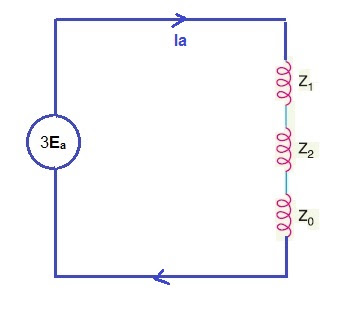In earlier posts we discussed, Concept of Symmetrical Components and Calculation of Symmetrical Components. It is recommended to go through these topics before analyzing Single Line to Ground Fault.
Let us assume that a ground fault takes place in A phase (In many industries and numerical relays, normally the phases are said as A, B and C instead of R, Y and B, though they represent the same thing i.e. A phase means R phase, B means Y phase and C means B phase). Ea, Eb and Ecare the Generator terminal voltage per phase. Bold letters here represent vector form.
Because of ground fault in A phase, the voltage at the point of fault will become zero and current through the other phases i.e. B and C phases will become zero. Therefore we can write as
Va = 0
Ib = 0
Ic = 0
Therefore, from the Calculation of Symmetrical Components, we can write as
Ia0 = (Ia + Ib + Ic)/3
= Ia/3
Ia1 = (Ia + λIb + λ2Ic)/3
= Ia/3
and,
Ia2 = (Ia + λ2Ib + λIc)/3
= Ia/3
From the above expressions of positive, negative and zero sequence components of current in faulted phase A, we observe that all the sequence currents are equal in magnitude and phase. Thus for faulted phase, in case of Single Line to Ground Fault, we can write
Ia0= Ia1 = Ia2 = Ia/3
Calculation of Fault Current:
First thing which must be understood at this point, that fault current is completing its path through the grounded neutral. If there were no any grounded neutral, no fault current would have been flow.
We will apply Kirchhof’s voltage law here to find the fault current. As fault current is only flowing in the faulted phase A, therefore we are only interested in finding Ia.
Ea = Va + Ia0Z0 + Ia1Z1+ Ia2Z2
= 0 + Ia0Z0+ Ia1Z1 + Ia2Z2
⇒ Ea = Ia0Z0 + Ia1Z1 + Ia2Z2
But Ia0 = Ia1= Ia2 = Ia/3 so,
Ea = Ia/3 Z0 + Ia/3 Z1 + Ia/3 Z2
⇒ Ia = 3Ea / (Z0 + Z1+ Z2)
From the above expression of fault current, it is quite clear that positive, negative and zero sequence impedance are connected in series for Single Line to Ground Fault and the equivalent circuit may be represented as shown below.
The above expression for fault current has been derived assuming that the neutral of the system is solidly grounded. For a system where neutral is grounded through some finite resistance, say Z, then the fault current would be given as
Ia= 3Ea / (Z0 + Z1 + Z2+ Z)
It shall also be noted that, for ungrounded system or isolated neutral system as there is no path for neutral current to flow, therefore the impedance seen by zero sequence current will be infinite (as only zero sequence current flows through the neutral) and hence the value of zero sequence component of fault current will be zero.
You may like to read Concept of Neutral Grounding.
Calculation of Voltage of Healthy and Faulty Phases:
Since the generated voltage of Generator is positive sequence voltage, therefore
Ea0 = 0
Ea1 = Ea
Ea2 = 0
Now, the positive sequence voltage at the point of fault
Va1 = Ea – Ia1Z1
= Ea – EaZ1/ (Z0 + Z1+ Z2)
⇒ Va1 = (Z2 + Z0)Ea/ (Z0 + Z1 + Z2)
Similarly,
Va2= 0 – Ia2Z2
= –Ea Z2/ (Z0 + Z1 + Z2)
and
Va0 = 0 – Ia0Z1
= Ea Z0/ (Z0+ Z1 + Z2)
Thus we have calculated the sequence components of voltages of faulty phase. For calculating the voltages of healthy phase we will apply the concept of symmetrical components as shown below.
Vb= Vb0 + λ2Vb1 + λVb1
Vc= Vc0 + λVc1 + λ2Vc1
In this way, we can calculate the level of earth fault current in Single Line to Ground fault and voltages of different phases.


I’m a student who wants to write a project and the topic is, how to detect a fault on the low voltage side of a distribution transformer.
Kindly let us know if we can help in any way.
Why LG fault becomes more severe when fault occurs in generator terminal?